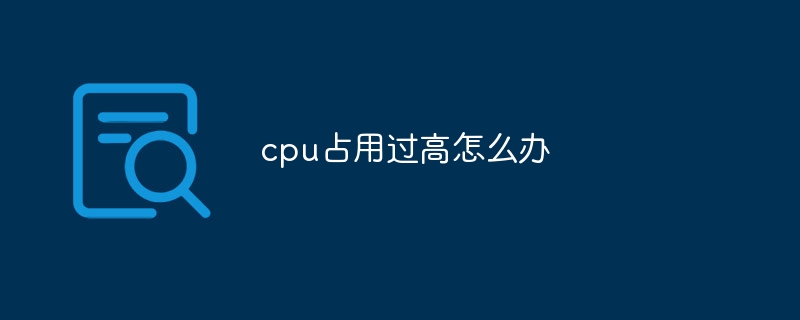Home >Common Problem >What to do if the CPU usage is too high
Solutions to excessive CPU usage include task manager, closing useless programs, anti-virus software, hardware upgrades, system optimization, reducing program priority, turning off special effects, updating drivers, turning off automatic updates, and regular maintenance. Check for cooling issues, disable unnecessary startup items, reinstall programs, check power plans, or check for hardware failures. Detailed introduction: 1. Task Manager, open the Windows Task Manager and so on by pressing the "Ctrl Alt Delete" or "Ctrl Shift Esc" key combination.

When the CPU usage is too high, you can take the following measures to solve the problem:
1. Task Manager: Press Ctrl Alt Delete or Ctrl Shift Esc key combination to open the Windows Task Manager to see which programs are occupying CPU resources. If you find an abnormal program, you can select it and click the "End Task" button to stop the program from running.
2. Close useless programs: Check system settings and close unnecessary programs and plug-ins to reduce CPU load. The specific method is to select "Programs and Features" in "Control Panel", then select the program you no longer need and click the "Uninstall" button. For some plug-ins, you can also uninstall them through the corresponding program.
3. Anti-virus software: Install and update anti-virus software, and conduct a comprehensive system scan to eliminate viruses or malware from occupying CPU resources. In some cases, anti-virus software may falsely report a normal program as a virus and process it, so you need to make a judgment based on the actual situation.
4. Hardware upgrade: If none of the above measures can solve the problem, you can consider upgrading the CPU or increasing the memory. Upgrading the CPU can improve the performance of the processor, while adding memory can reduce the burden on the CPU. When purchasing hardware, it is recommended to choose a model that is compatible with the motherboard and ensure that the upgraded hardware will work well with the existing configuration.
5. System optimization: Use system optimization tools for optimization, such as Windows Optimization Master, CCleaner, etc. These tools can help you clean up system junk, shut down unnecessary services, optimize the registry, etc., thereby reducing CPU usage.
6. Reduce the priority of the program: In the task manager, right-click the program that takes up more CPU and select "Set Priority" to lower the priority of the program. This can reduce the program's usage of CPU resources.
7. Turn off special effects: In some cases, complex special effects may cause excessive CPU usage. Try turning off special effects in games or video playback software, or lowering the display resolution and effect level to reduce the load on the CPU.
8. Update drivers: Make sure the drivers on your computer are up to date. Outdated drivers can cause performance degradation and increased resource usage. Visit the device manufacturer's official website or use a driver update tool such as Driver Easy to obtain the latest driver and install it.
9. Turn off automatic updates: Turn off the automatic update function, especially for Windows operating systems. Automatic updates can cause high usage of system resources, especially when doing large-scale updates. You can turn off automatic updates through the following steps:
10. Regular maintenance: Regularly defragment the disk and clean up system junk files to optimize computer performance and reduce CPU usage. You can use Windows' built-in disk defragmentation tool or a third-party maintenance tool to accomplish this task.
11. Check the cooling problem: Make sure the computer’s cooling system is working properly. If the CPU overheats, it will cause performance degradation and increased resource usage. Check whether the cooling fan is operating properly and clean the dust and other impurities on the radiator.
12. Disable unnecessary startup items: Reduce resource usage during system startup by disabling unnecessary startup items. In Windows systems, you can use Task Manager or third-party tools such as Autoruns to disable unnecessary startup items.
13. Reinstall the program: If the above measures fail to solve the problem, you can try to reinstall the problematic program or component. Before reinstalling, please uninstall the original program or component and download the latest version from the official website or other reliable sources.
14. Check the power plan: Make sure the computer's power plan is set appropriately. For Windows operating systems, you can check the power plan settings in Control Panel. Make sure you select the appropriate power plan and adjust it as needed.
15. Check for hardware failure: If none of the above measures can solve the problem, it may be that the CPU usage is too high due to hardware failure. In this case, it is recommended to contact a computer repair professional for inspection and repair.
The above is the detailed content of What to do if the CPU usage is too high. For more information, please follow other related articles on the PHP Chinese website!